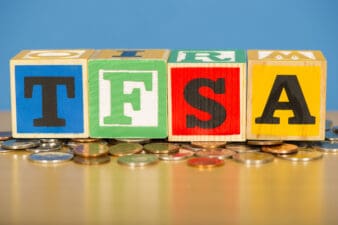The RRSP is the most popular retirement savings vehicle in Canada. Providing tax deductible contributions and tax-deferred compounding, it gives Canadians the opportunity to grow their savings.
Many Canadians rely almost entirely on their RRSPs for retirement saving. According to a recent StatCan report, only 40% of working Canadians are covered by employer sponsored pension plans, which leaves 60% relying on CPP, OAS and their RRSPs for retirement.
According to Benefits Canada, the average Canadian retiree has $2,600 in monthly expenses. With CPP and OAS paying only about $1,300 a month combined (on average), that leaves the RRSP to pay for about half.
The problem here is that most peoples’ RRSPs will never pay $1,300 a month. According to a BMO study, the average Canadian’s RRSP was worth about $101,000. That pays roughly $3,000 a year at a 3% average portfolio yield. Granted, older Canadians have more in their RRSPs than younger Canadians.
But the same study that found Canadians had $101,000 in their RRSPs on average, also found that Baby Boomers had only $178,664. Again, at an average portfolio yield of 3%, that produces nowhere near $1,300 a month.
Basically, if you’re a Canadian with an average RRSP balance, your RRSP won’t be enough for retirement. On the surface, that seems like bad news. However, there is a silver lining. While you won’t be able to fund your retirement with an average RRSP, you can take steps to make yours go further.
Additionally, with the right investments, you can watch your holdings grow over time. I’ll explore that in a minute. First, let’s take a look at how much money you’ll actually need to retire.
How much a Canadian needs to retire in 2020
The amount that Canadians need to retire varies depending on individual circumstances. However, the average amount Canadians think they’ll need, according to a CIBC study, is $756,000. Age plays a factor in estimates.
Millennials believe they’ll need more, at $917,000, while Baby Boomers think they’ll need less, at $518,000. This makes sense, because the farther into the future an individual’s retirement is, the more inflation will have eaten into the loonie.
Why your RRSP won’t be enough
If you’re like most Canadians, your RRSP probably has nowhere near $756,000 in it. As previously mentioned, the average RRSP has only a $101,000 balance. If you’re near that level, you don’t have enough to retire on. That doesn’t mean, however, that you need to give up on RRSPs entirely.
If you still have a ways to go until retirement, you can build up your balance by contributing regularly, and by following an aggressive investment mandate. By “aggressive,” I don’t mean penny stocks and tech startups, but simply a high concentration in equities.
Consider the iShares S&P/TSX 60 Index Fund (TSX:XIU). Compared to bonds and GICs, this is an “aggressive,” “risky” investment. Its price varies with the market. Its constituent companies may under-perform. Its dividends are not legally guaranteed.
Like all equities, it’s riskier than government bonds. But with a portfolio of 60 large cap stocks, much of its risk is diversified away, leaving a “safe” overall package.
By contributing regularly to your RRSP and buying ETFs like XIU, you’ll gradually build up an income-producing portfolio that can carry you through your golden years. The actual value of your holdings is not guaranteed.
But if you contribute $26,500 a year over 30 years and the fund’s value stays flat, you’ll end up with a $795,000 position. Assuming a 3% yield, that will pay you $23,850 a year–a decent income supplement in retirement.








